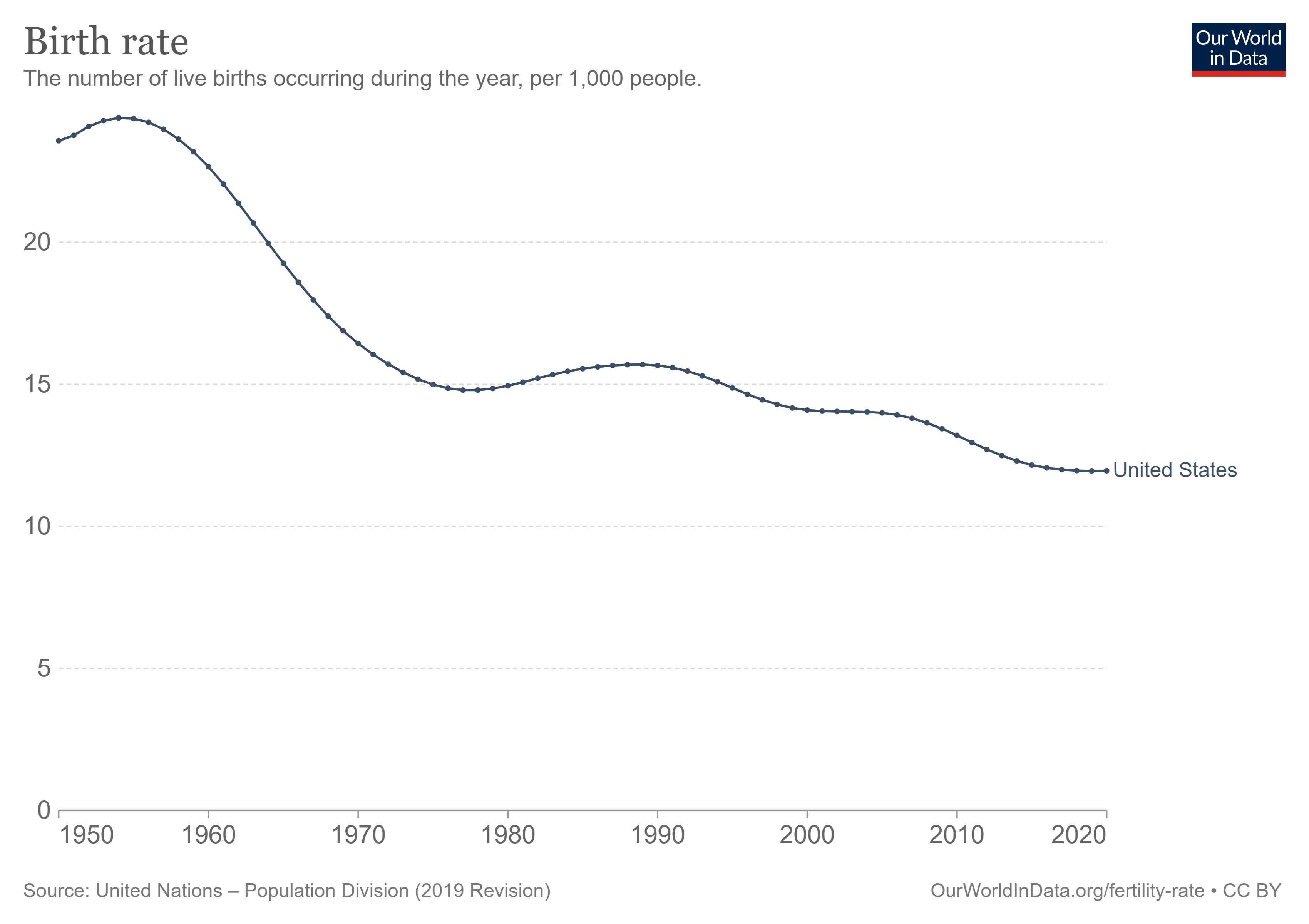by Hannah Cox
Elon Musk recently tweeted, “population collapse is the biggest threat to civilization.”
Population collapse is the biggest threat to civilization https://t.co/ZrHN5DsrVB
— Elon Musk (@elonmusk) May 24, 2022
The tweet included a link to an interview Musk gave where he expanded on the subject. “Assuming there’s a benevolent future with AI, I think the biggest problem the world will face in 20 years is population collapse,” Musk wrote. “Collapse. I want to emphasize this….Not explosion, collapse.”
Musk has been known to raise this concern in the past too. Last year he told the Wall Street Journal, “I can’t emphasize this enough, there are not enough people.” He also said that low and rapidly declining birth rates are “one of the biggest risks to civilization.”
That the wealthiest and arguably one of the smartest men on earth spends his days fixating on this issue should be a signal to others that things might be more dire than they think.
According to the US Census, “The US population grew at a slower rate in 2021 than in any other year since the founding of the nation.” And we’re not alone. According to reporting by the BBC, “Researchers at the University of Washington’s Institute for Health Metrics and Evaluation showed the global fertility rate nearly halved to 2.4 in 2017 – and their study, published in the Lancet, projects it will fall below 1.7 by 2100.”
Population replacement rates are important for a society to sustain itself. We need people to be born so that there are workers to fill the various needs of the whole. Old men cannot do the labor young men can do, young adults are needed to care for the dying and aging. Fewer people means less economic activity, smaller GDPs, less innovation, and less competition.
It also means we have less division of labor. As Adam Smith wrote in The Wealth of Nations, “The division of labor is limited by the extent of the market.“ That means people are less able to specialize and lean into their preferences or areas of expertise in their work.
As a whole, the machine slows and then stagnates when new firewood is not added to the furnace.
But while Elon Musk is absolutely correct about the problem and the potential threat it poses to society, he has not addressed (as far as I’ve seen) the underlying issues creating it or discussed how they might be solved.
So, in an effort to address these issues, here are five reasons people are increasingly choosing not to procreate, along with the free-market responses that could address them.
1. Higher Opportunity Costs for Women
The simple fact is, some people don’t want children. And there are legitimate reasons for that choice.
No matter what Sheryl Sandberg wants you to believe, women cannot have it all. “Leaning in” is a practice that has left most women who attempt it barrelled over in pain.
The reality is, while women tend to work outside the home in most partnerships now, the vast majority of childcare and household work continues to be laid at their feet. This is an ongoing issue that causes many women to choose not to have kids or not to have more kids.
In life, just as in economics, there are trade-offs. Most women realize they will likely not be able to be a successful career woman, a dedicated mother, and a jaw-dropping homemaker all at the same time. There are choices to be made here, and some women are simply deciding that motherhood is the role they can let go.
It’s important to point out that these are choices that used to be harder to make. In generations past, women were shamed for not having kids, ostracized in society, or simply did not have the access to birth control they needed to determine their own pathway. We’re moving away from that kind of culture, and the advancements in women’s healthcare have empowered women to set their own course.
2. More Americans (Men and Women) Don’t Want to Have Kids
As a woman who has never wanted children, I’ve thought deeply about this topic. And I believe there are many others who are looking at the same factors I am and reaching the same conclusion.
Motherhood is hard, physically, emotionally, and mentally. I personally never wanted to go through the pain of childbirth, nor do I want to give myself the mental and emotional anxiety that comes with taking on this role. But as pointed out above, this wasn’t always a calculation afforded to women.
Furthermore, I love working—always have. And I’ve built a meaningful and impactful career I’d never be willing to give up. While some women choose to work and have kids, that’s not a situation I’d choose for myself. I’d never put my kids in government schools nor would I want them to spend their time with others in daycare. So when faced with the choice of pursuing my work or raising kids, I simply choose the former. It’s where I want to spend my time. I’ve met many others who feel the same way as me.
There are other factors as well. While the world has actually been improving (though you wouldn’t know it based on the media), there are many people (myself included) who look around and still don’t find the world to be one they’d want to bring kids into.
Thanks to birth control and the gains made under feminism, these are choices women now get to make that other generations simply were not afforded. As a whole, this is a choice that should be accepted and even celebrated by society.
Are there free market solutions to these factors? Sure. School choice would make it easier for women to homeschool or find other alternatives. Remote work would allow more people to balance child-rearing with their careers. And improvements in our social climate would likely make people more optimistic about procreating.
Still, the simple truth is, there are fewer people who want to bring kids into the world. Though the reasons are diverse, 44 percent of non-parents between 18 to 49 say it is not to or not at all likely they will procreate. And that’s ok. But for those who do want kids, we should strive to create a world where that option is as feasible as possible.
While some women and men are simply choosing not to have kids, others wish to and cannot find adequate partners.
It’s important to remember that we are still merely a few decades into a new normal: the sexes having equal rights and a fair playing field.
While this is long-overdue progress that should obviously be celebrated, it also means the social fabric of our society is still fraught with landmines. For all of human history, women and men have not been in a situation where they were equal under the law.
That means culturally and biologically women are programmed to look for partners who are stronger and wealthier than they are, because those elements were essential for survival for most of our existence. But in recent decades, women are largely surpassing men economically. They are more likely to obtain degrees, are catching up to men in their earnings, and in 37 percent of US households, women pay the bills.
To this, many will say women should just lower their standards or not be so picky. But it’s not that simple. Again, to do that requires overcoming significant evolutionary impulses on the part of women. And even when they do overcome these factors, it still isn’t working out. In fact, marriages with female breadwinners are 50 percent more likely to end in divorce. This illustrates that the power dynamic shift created between higher earning women and lower earning men is one our society has not yet learned to live with.
Furthermore, while men say they are fine with dating women who are smarter than them, psychological studies have revealed otherwise. Men are also biologically inclined to be providers and to be competitive. But for the first time in history, they’re having to compete with women, and outcome wise, they’re often ending up in second place. It turns out they don’t find this so appealing in practice.
The fact that LDS and evangelical families are still having more children backs all of this up. Since gender norms are changing more slowly in these communities, it would seem their relationships are not suffering the same growing pains and therefore the number of children they are having is falling more slowly.
These are societal problems, not ones suited for public policy. And the harsh reality is that it will probably take decades for us to sort out this new landscape for romantic relationships and for people to evolve past the male provider/female nurturer gender stereotypes. But they are challenges worth examining and overcoming, and at an individual level, we can all look for ways to foster romantic relationships that take these factors into consideration.
4. Raising Children Is Getting Super Expensive
Even for people who do want to have kids and manage to find the right partner, there are still a multitude of landmines they must overcome before they can comfortably procreate, and they all trace back to affordability.
A flourishing society would naturally incentivize people to procreate. But that requires a steady currency, good job market, relatively safe communities, the promise of a good education, and economic factors that make it affordable to have and raise a child.
According to Merrill Lynch, it currently costs $230,000 to raise a kid to age 18. That’s a jaw-dropping amount, especially when one considers record-breaking inflation, wage stagnation, and economic uncertainty created by the reckless printing and spending policies of the US government.
The reasons for these high costs also trace back to the government. Childcare costs have been soaring for decades thanks to extreme government regulations and restrictions on these services. In one survey, 85 percent of parents reported spending 10 percent or more of their household income on child care.
Education is another major financial calculation in these decisions. There’s no way to sugarcoat it, government schools are atrocious and private schooling or alternative options can be expensive or unfeasible. Many parents are also hesitant to place their kids in government schools because of gun-free zones that make them sitting ducks.
And then there’s college. The price of higher education is astronomical, and that is solely due to government subsidies and loans. But while evidence increasingly shows college is not a good investment for most, many parents still desire to give their kids every opportunity they can and thus factor this in.
Additionally, healthcare costs continue to rise in the country thanks to the government increasingly taking over our system. Insurance prices shot up after Obamacare and there is no end in sight for many.
Finally, there are the costs of infertility. A growing number of Americans are having trouble getting pregnant when they want to. Some blame this on problems with our nutrition. Others say it’s because people are having kids later in life. Likely there are multiple reasons. But whatever the cause, fertility assistance is extremely expensive and a cost many cannot afford.
Relatedly, many economists point to the quantity-quality tradeoff theory which implies that a reduction in fertility would lead to more human capital investment per child. Meaning, people would rather invest their love, finances, and attention into a smaller number of children versus spreading it across a large family.
There are many public policy reforms that would bring these costs down. But for the time-being it is understandable why for some the math is simply not adding up. People want to know they can give their kids a brighter and better future than they themselves had, and for now, that simply isn’t true for a lot of people.
5. Demographic Transition Theory
Finally, many economists point to something called the demographic transition theory to explain the decrease in childbirth. In short, because child mortality rates have dropped so precipitously under capitalism people don’t have to have as many kids.
In generations past, as terrible as it was, parents would have a lot of kids with the assumption that several would die. That is no longer the case. People can plan how many children they want to have with a high level of certainty that those kids will live into adulthood.
Furthermore, as societies have become less male-centric, parents don’t have to keep having kids until they have a boy. For inheritance, property, and societal reasons, this used to be a goal for many people, but it is one that is quickly diminishing.
Many of these are issues we as a society can address through free-market solutions. It’s time we have that conversation.
– – –
Hannah Cox is the Content Manager and Brand Ambassador for the Foundation for Economic Education.






